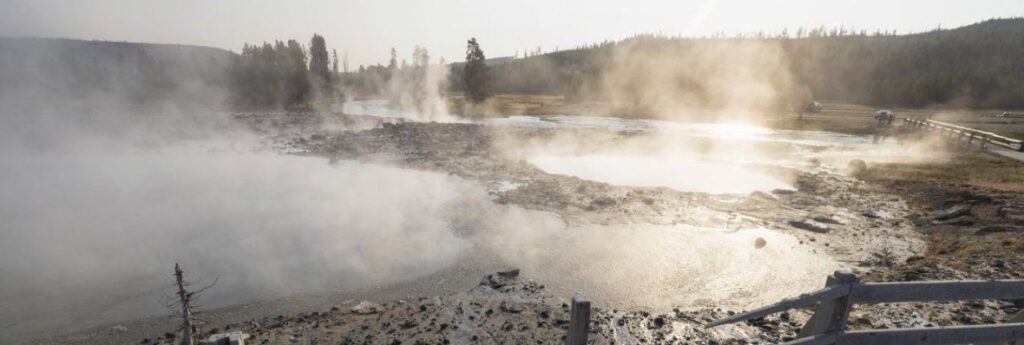A surprise eruption of steam in a Yellowstone National Park geyser basin sent people scrambling for safety as basketball-sized rocks flew overhead, highlighting the US parks hydrothermal activities that attract millions of tourists annually are dangerous and not as predictable as Old Faithful, which erupts “like clockwork.”
Though the explosion in Biscuit Basin caused no injuries, dozens of people fled down the boardwalk before the wooden walkway was destroyed. The blast sent rocks, steam, water and dirt high into the air, according to a witness and a scientist who reviewed video footage of the event.
It came in a park teeming with geysers, hot springs and other hydrothermal features, are well understood by the scientists who monitor the park’s seismic activity, but the type of explosion that happened last week is less common and understood, and potentially more hazardous given that they happen without warning.
“This drives home that even small events – and this one in the scheme of things was relatively small, if dramatic – can be really hazardous,” said Michael Poland, lead scientist at the Yellowstone Volcano Observatory. “We’ve gotten pretty good at being able to understand the signs that a volcano is waking up and may erupt. We don’t have that knowledge base for hydrothermal systems like the one in Yellowstone.”
Poland and other scientists are trying to change that with a fledgling monitoring system that was recently installed in another Yellowstone geyser basin. It measures seismic activity, deformations in the Earth’s surface and low-frequency acoustic energy that could signal an eruption.
The hydrothermal explosions are believed to result from clogged passageways in the extensive natural plumbing network under Yellowstone, Poland said. A clog could cause the heated, pressurized water to turn into steam instantly and explode.
Last week’s explosion came with little warning.
Witness Vlada March, who captured widely circulated video of the explosion, said steam started rising in the Biscuit Basin “and within seconds, it became this huge thing. … It just exploded and became like a black cloud that covered the sun.”
March’s tour guide, Isaac Fisher, said he heard a hiss coming from Cliff Pool and told his group it was unusual. It looked like a geyser erupting 18 to 21 metres into the air for a few seconds and then, “Ba-boom!” he said.
“You felt the shock wave hit your chest and vibrate the bones in your chest,” he said. “The explosion was so significant you felt your feet shaking. You felt the boardwalk shake and you felt everything shaking.”
He estimated the whole event lasted about 25 seconds as the debris plume climbed to about 100 meters into the air.
“I cannot believe nobody got hurt,” Fisher said. “There were rocks whizzing over our heads that were the size of basketballs.”
Yellowstone encompasses the caldera of a huge, slumbering volcano that shows no sign of erupting any time soon but provides the heat for the national park’s famous geysers, hot springs, mud pots and various other hydrothermal features. While far less common than geyser eruptions, hydrothermal explosions happen often enough in Yellowstone to be studied — and to be a safety concern.
Yet even if explosions such as the recent one in Yellowstone could be predicted, there’s no feasible way to prevent them, said Poland.
“One of the things people ask me occasionally is, ‘How do you stop a volcano from erupting?’ You don’t. You get out of the way,” Poland said. “For any of this activity, you don’t want to be there when it happens.”

